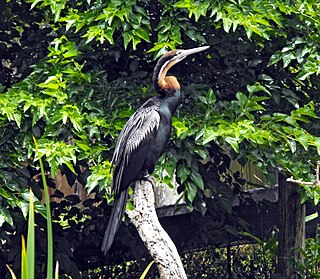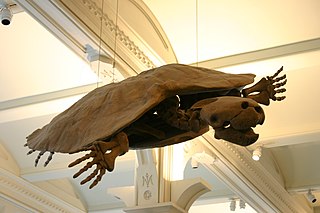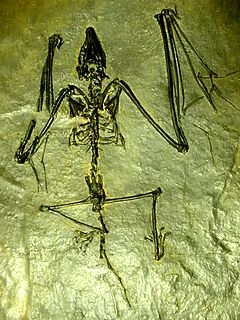
The darters, anhingas, or snakebirds are mainly tropical waterbirds in the family Anhingidae, which contains a single genus, Anhinga. There are four living species, three of which are very common and widespread while the fourth is rarer and classified as near-threatened by the IUCN. The term snakebird is usually used without any additions to signify whichever of the completely allopatric species occurs in any one region. It refers to their long thin neck, which has a snake-like appearance when they swim with their bodies submerged, or when mated pairs twist it during their bonding displays. "Darter" is used with a geographical term when referring to particular species. It alludes to their manner of procuring food, as they impale fishes with their thin, pointed beak. The American darter is more commonly known as the anhinga. It is sometimes called "water turkey" in the southern United States; though the anhinga is quite unrelated to the wild turkey, they are both large, blackish birds with long tails that are sometimes hunted for food.

The Coraciiformes are a group of usually colourful birds including the kingfishers, the bee-eaters, the rollers, the motmots, and the todies. They generally have syndactyly, with three forward-pointing toes, though in many kingfishers one of these is missing.

The mousebirds are birds in the order Coliiformes. They are the sister group to the clade Eucavitaves, which includes the Leptosomiformes, Trogoniformes (trogons), Bucerotiformes, Piciformes and Coraciformes. This group is now confined to sub-Saharan Africa, and it is the only bird order confined entirely to that continent, with the possible exception of turacos which are considered by some as the distinct order Musophagiformes, and the cuckoo roller, which is the only member of the order Leptosomiformes. Mousebirds had a wider range in the Paleogene, with a widespread distribution in Europe and North America during the Paleocene.

Carettochelyidae is a family of cryptodiran turtles belonging to the Trionychia. It contains only a single living species, the pig-nosed turtle native to New Guinea and Northern Australia. Stem-group carettochelyids are known from the Cretaceous of Asia, with the family being widely distributed across North America, Europe and Asia during the Paleogene.

Podocnemididae is a family of pleurodire (side-necked) turtles, once widely distributed. Most of its 20 genera and 30 species are now extinct. Seven of its eight surviving species are native to South America: the genus Peltocephalus, with only one species ; and the genus Podocnemis, with six living species of South American side-necked river turtles. There is also one genus native to Madagascar: Erymnochelys, the Madagascan big-headed turtle, whose single species E. madagascariensis.

The Messel Pit is a disused quarry near the village of Messel about 35 km (22 mi) southeast of Frankfurt am Main, Germany. Bituminous shale was mined there. Because of its abundance of fossils, it has significant geological and scientific importance. After almost becoming a landfill, strong local resistance eventually stopped these plans and the Messel Pit was declared a UNESCO World Heritage Site on 9 December 1995. Significant scientific discoveries are still being made and the site has increasingly become a tourist site as well.

Propalaeotherium was an early genus of equid endemic to Europe and Asia during the Early Eocene.

Mantispidae, known commonly as mantidflies, mantispids, mantid lacewings, mantisflies or mantis-flies, is a family of small to moderate-sized insects in the order Neuroptera. There are many genera with around 400 species worldwide, especially in the tropics and subtropics. Only 5 species of Mantispa occur in Europe. As their names suggest, members of the group possess raptorial forelimbs similar to those of praying mantis, a case of convergent evolution.

Stupendemys is an extinct genus of freshwater side-necked turtle, belonging to the family Podocnemididae. It is the largest freshwater turtle known to have existed, with a carapace over 2 metres long. Its fossils have been found in northern South America, in rocks dating from the Middle Miocene to the very start of the Pliocene, about 13 to 5 million years ago. Male specimens are known to have possessed bony horns growing from the front edges of the shell and the discovery of the fossil of a young adult shows that the carapace of these turtles flattens with age. A fossil skull described in 2021 indicates that Stupendemys was a generalist feeder.

Palaeochiropteryx is an extinct genus of bat from the Middle Eocene of Europe. It contains two very similar species – Palaeochiropteryx tupaiodon and Palaeochiropteryx spiegeli, both from the famous Messel Pit of Germany. They are usually found complete and exceptionally preserved, even retaining the outlines of their fur, ears, and wing membranes.
Paleontology or palaeontology is the study of prehistoric life forms on Earth through the examination of plant and animal fossils. This includes the study of body fossils, tracks (ichnites), burrows, cast-off parts, fossilised feces (coprolites), palynomorphs and chemical residues. Because humans have encountered fossils for millennia, paleontology has a long history both before and after becoming formalized as a science. This article records significant discoveries and events related to paleontology that occurred or were published in the year 1998.

Iberosuchus is a genus of extinct sebecosuchian mesoeucrocodylian found in Western Europe from the Eocene. Remains from Portugal was described in 1975 by Antunes as a sebecosuchian crocodilian. This genus has one species: I. macrodon. Iberosuchus was a carnivore, unlike the crocodilians today, they are not aquatic and are instead terrestrial.

Archaeonycteris is an archaic bat genus whose fossilised remains have been found in Germany, France, England and India.

Archaeonycteridae is a family of extinct bats. It was originally erected by the Swiss naturalist Pierre Revilliod as Archaeonycterididae to hold the genus Archaeonycteris. It was formerly classified under the superfamily Icaronycteroidea (disused) by Kurten and Anderson in 1980. In 2007, the spelling was corrected to Archaeonycteridae and it was reclassified to the unranked clade Microchiropteramorpha by Smith et al.. The family Palaeochiropterygidae was also merged into Archaeonycteridae by Kurten and Anderson, but modern authorities specializing in bat fossils maintain the distinction between the two.
The Balumtun Sandstone is a geologic formation in Chiapas, Mexico. The formation is up to 760 metres thick, and consists of gray sandstone, that were deposited during the Upper Aquitanian stage of the Early Miocene.
The Mazantic Shale is a geologic formation in Chiapas, Mexico. It was deposited during the Early Miocene (Aquitanian). The formation comprises dark gray shales that were deposited in a marine environment. It preserves fossils, such as the turtle Allaeochelys liliae. Amber as been recovered from it.
This list of fossil reptiles described in 2020 is a list of new taxa of fossil reptiles that were described during the year 2020, as well as other significant discoveries and events related to reptile paleontology that occurred in 2020.
Jens Lorenz Franzen was a German paleontologist. He was the head of Paleoanthropology and Quaternary at Naturmuseum Senckenberg in Frankfurt and participated in fossil excavation in Germany. He worked with scientific excavations and discovered many previously unknown fossil mammal species.
This list of fossil reptiles described in 2021 is a list of new taxa of fossil reptiles that were described during the year 2021, as well as other significant discoveries and events related to reptile paleontology that occurred in 2021.












